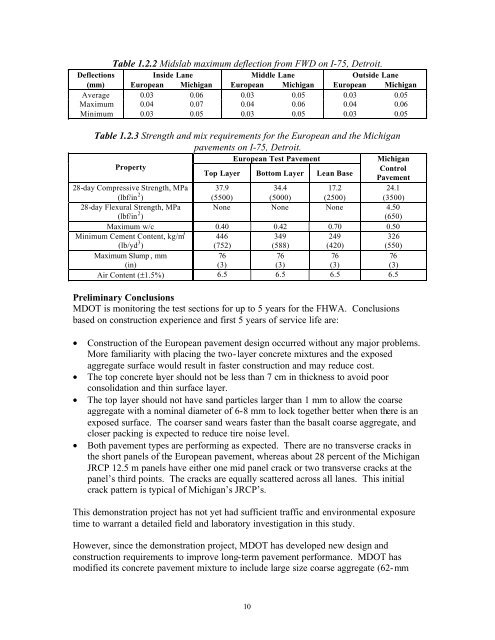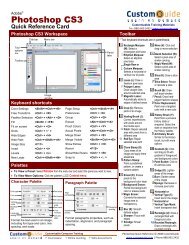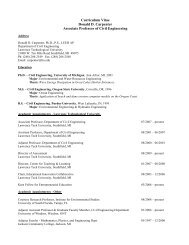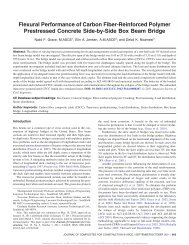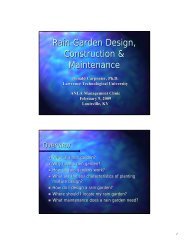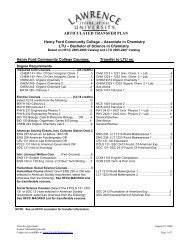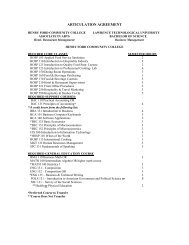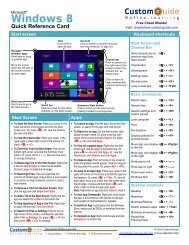The Effects of Higher Strength and Associated Concrete Properties ...
The Effects of Higher Strength and Associated Concrete Properties ...
The Effects of Higher Strength and Associated Concrete Properties ...
You also want an ePaper? Increase the reach of your titles
YUMPU automatically turns print PDFs into web optimized ePapers that Google loves.
Table 1.2.2 Midslab maximum deflection from FWD on I-75, Detroit.<br />
Deflections Inside Lane Middle Lane Outside Lane<br />
(mm) European Michigan European Michigan European Michigan<br />
Average 0.03 0.06 0.03 0.05 0.03 0.05<br />
Maximum 0.04 0.07 0.04 0.06 0.04 0.06<br />
Minimum 0.03 0.05 0.03 0.05 0.03 0.05<br />
Table 1.2.3 <strong>Strength</strong> <strong>and</strong> mix requirements for the European <strong>and</strong> the Michigan<br />
pavements on I-75, Detroit.<br />
European Test Pavement<br />
Property<br />
Top Layer Bottom Layer Lean Base<br />
Michigan<br />
Control<br />
Pavement<br />
28-day Compressive <strong>Strength</strong>, MPa<br />
(lbf/in 2 )<br />
37.9<br />
(5500)<br />
34.4<br />
(5000)<br />
17.2<br />
(2500)<br />
24.1<br />
(3500)<br />
28-day Flexural <strong>Strength</strong>, MPa<br />
(lbf/in 2 )<br />
None None None 4.50<br />
(650)<br />
Maximum w/c 0.40 0.42 0.70 0.50<br />
Minimum Cement Content, kg/m 3<br />
(lb/yd 3 )<br />
446<br />
(752)<br />
349<br />
(588)<br />
249<br />
(420)<br />
326<br />
(550)<br />
Maximum Slump , mm<br />
(in)<br />
76<br />
(3)<br />
76<br />
(3)<br />
76<br />
(3)<br />
76<br />
(3)<br />
Air Content (±1.5%) 6.5 6.5 6.5 6.5<br />
Preliminary Conclusions<br />
MDOT is monitoring the test sections for up to 5 years for the FHWA. Conclusions<br />
based on construction experience <strong>and</strong> first 5 years <strong>of</strong> service life are:<br />
• Construction <strong>of</strong> the European pavement design occurred without any major problems.<br />
More familiarity with placing the two-layer concrete mixtures <strong>and</strong> the exposed<br />
aggregate surface would result in faster construction <strong>and</strong> may reduce cost.<br />
• <strong>The</strong> top concrete layer should not be less than 7 cm in thickness to avoid poor<br />
consolidation <strong>and</strong> thin surface layer.<br />
• <strong>The</strong> top layer should not have s<strong>and</strong> particles larger than 1 mm to allow the coarse<br />
aggregate with a nominal diameter <strong>of</strong> 6-8 mm to lock together better when there is an<br />
exposed surface. <strong>The</strong> coarser s<strong>and</strong> wears faster than the basalt coarse aggregate, <strong>and</strong><br />
closer packing is expected to reduce tire noise level.<br />
• Both pavement types are performing as expected. <strong>The</strong>re are no transverse cracks in<br />
the short panels <strong>of</strong> the European pavement, whereas about 28 percent <strong>of</strong> the Michigan<br />
JRCP 12.5 m panels have either one mid panel crack or two transverse cracks at the<br />
panel’s third points. <strong>The</strong> cracks are equally scattered across all lanes. This initial<br />
crack pattern is typical <strong>of</strong> Michigan’s JRCP’s.<br />
This demonstration project has not yet had sufficient traffic <strong>and</strong> environmental exposure<br />
time to warrant a detailed field <strong>and</strong> laboratory investigation in this study.<br />
However, since the demonstration project, MDOT has developed new design <strong>and</strong><br />
construction requirements to improve long-term pavement performance. MDOT has<br />
modified its concrete pavement mixture to include large size coarse aggregate (62-mm<br />
10


